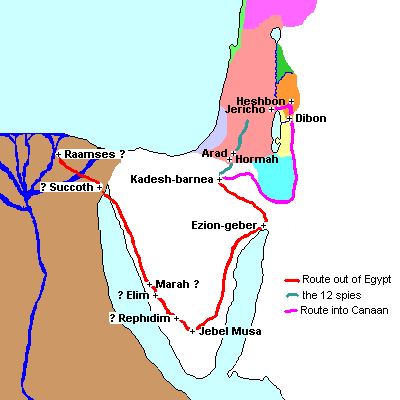Geography Pages
The Exodus
All boundaries, and borders of countries, are approximate
The territory controlled by a king or people varied from time to time, and was often disputed by other peoples. Even the coast-line has varied over the years, particularly in the Gulf of Persia. An approximation to the modern coast-line is generally used in the maps. The sites of some ancient cities and towns are now not known with certainty
There were several possible routes which the Israelites could have taken on leaving Egypt.
One possibility is that they kept close to the Mediterranean coast - however, there were Egyptian outposts and guards along the "Way of the Sea", so this seems less probable.
Another theory is that they crossed from the Sinai peninsular, across the Gulf of Aqabah to northern Arabia, and that the mountain from which God gave the Ten Commandments was another Jebel Musa (Mountain of Moses), in Arabia.
The route shown here is the one most commonly accepted, with Jebel Musa (the highest peak of the Sinai range) as Mount Sinai.
 |
|
|
|
Egypt had extended her influence into Canaan, with military strongholds along the Mediterranean coast North of Canaan the Egyptians came into conflict with the Hittite Empire which was gaining control of Syria |
| The Canaanites were a group of Semitic peoples who lived in small city states. They appear to have been descended from northern invaders and the earlier indigenous population | |
| The Phoenicians controlled the northern sea coast, with major city states at Tyre and Sidon, and also at Dor, south of Mount Carmel | |
| The Arameans were nomadic Semites who moved into the region to the north of Canaan and established city states and kingdoms there | |
| The Philistines had invaded by sea, and settled along the Mediterranean coast. They knew how to make weapons of iron, which gave them an advantage over the other tribes and the incoming Israelites | |
| Gilead was a mountainous region which controlled the main route north-south, east of the Jordan, "The King's Highway" At the time of the Exodus it was claimed by Sihon, king of the Amorites, and by the Ammonites and the Aramaeans |
|
| The Ammonites claimed descent from Lot's younger surviving daughter (Genesis 19:30-38) | |
| The Moabites claimed descent from Lot's elder surviving daughter | |
| The Edomites claimed descent from Esau, the twin brother of Jacob |
![]()
![]() Go here for the History of the period
Go here for the History of the period
Copyright © 1999 Shirley J. Rollinson, all Rights Reserved